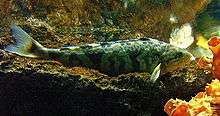Hexagrammidae
The family of marine fishes Hexagrammidae incorporates the greenlings. These fish are found on the continental shelf in the temperate or subarctic waters of the North Pacific. They are a well-known family in the littoral zone from southern California north to the Aleutian Islands. The most commercially important species is the lingcod (Ophiodon elongatus), a common food fish.
| Hexagrammidae | |
|---|---|
| Lingcod, Ophiodon elongatus | |
| Scientific classification | |
| Kingdom: | |
| Phylum: | |
| Class: | |
| Order: | |
| Suborder: | Hexagrammoidei |
| Family: | Hexagrammidae T. N. Gill, 1863 |
| Genera | |
Most hexagrammids are small to moderate in size, averaging around 50 cm, although the lingcod can be much larger. Like many other scorpaeniform species, they have broad, spiny pectoral, dorsal, and anal fins. They are scavengers but also catch and eat small fish and bottom-dwelling animals such as crabs. They can be found off rocky shorelines, in kelp beds, and, especially during spawning, in shallow inlets and tidepools.
The kelp greenling (Hexagrammos decagrammus) is a popular sport fish, and although it is not commercially valuable, it is considered a delicious food catch. The lingcod is long and olive-yellow in color, and has a very large, toothy mouth. The painted greenling (Oxylebius pictus) is smaller, brighter in color, and easily recognized by its large vertical red bands.
Genus and species
12 species in 5 genera:
- Genus Hexagrammos (Tilesius, 1810)
- Hexagrammos agrammus (Temminck y Schlegel, 1843)
- Hexagrammos decagrammus (Pallas, 1810) - Kelp greenling.
- Hexagrammos lagocephalus (Pallas, 1810) - Rock greenling.
- Hexagrammos octogrammus (Pallas, 1814)
- Hexagrammos otakii (Jordan y Starks, 1895)
- Hexagrammos stelleri (Tilesius, 1810) - Whitespotted Greenling.
- Genus Ophiodon (Girard, 1854)
- Ophiodon elongatus (Girard, 1854) - Lingcod.
- Genus Oxylebius (Gill, 1862)
- Oxylebius pictus (Gill, 1862) - Painted greenling
- Genus Pleurogrammus (Gill, 1861)
- Pleurogrammus azonus (Jordan y Metz, 1913)
- Pleurogrammus monopterygius (Pallas, 1810)
- Genus Zaniolepis (Girard, 1858)
- Zaniolepis frenata (Eigenmann y Eigenmann, 1889)
- Zaniolepis latipinnis (Girard, 1858)
 (Zaniolepis latipinnis)
(Zaniolepis latipinnis)- Lingcod(Ophiodon elongatus)
 (Pleurogrammus azonus)
(Pleurogrammus azonus) (Oxylebius pictus)
(Oxylebius pictus)
References
- ITIS
- Froese, Rainer, and Daniel Pauly, eds. (2006). "Hexagrammidae" in FishBase. February 2006 version.